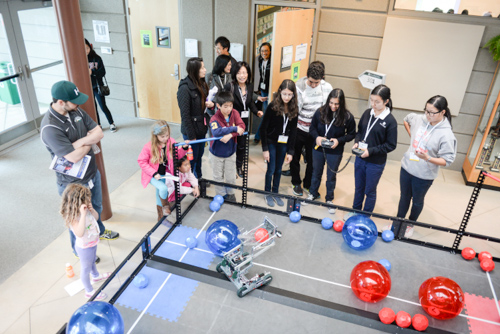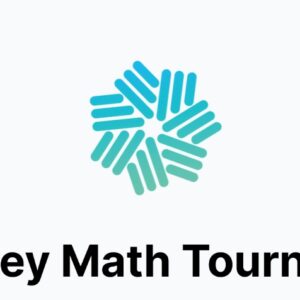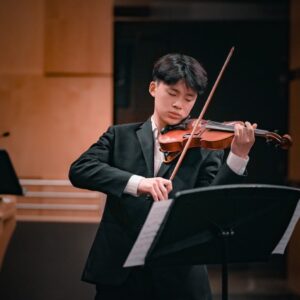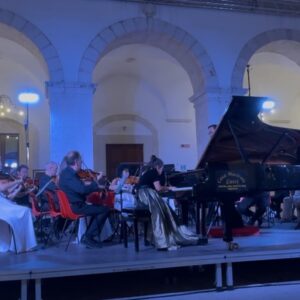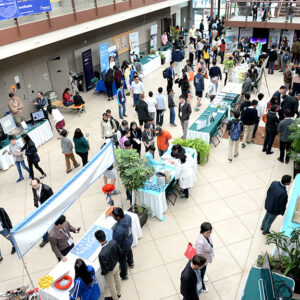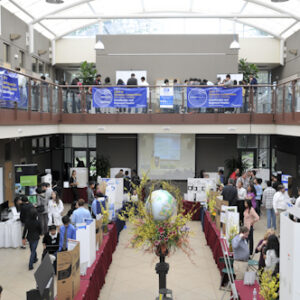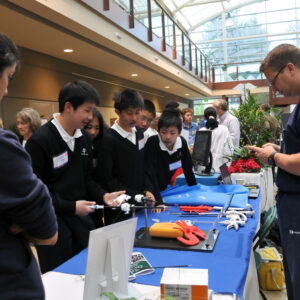UPDATE: Videos of the keynote speakers, breakout sessions and the panel discussion from this year’s Research Symposium are now available on YouTube.
Science enthusiasts from across the Harker community gathered at the upper school campus on March 29 for this year’s Harker Research Symposium. In the nearly 10 years since its founding, the research symposium has provided lovers of scientific research with an eventful day in which students, parents, faculty and staff meet to share their enthusiasm, see the results of student research and hear from notable members of the scientific community.
The Nichols Hall atrium was once again the epicenter of activity for the event, with exhibitors from companies such as Google, NVidia and the South Asian Heart Center providing information to passersby and holding tech demos. SeaLife Aquarium Maintenance, stationed in front of the atrium’s aquarium, gave attendees the opportunity to observe and touch starfish and other forms of aquatic life. Tesla Motors also had a presence, giving people a chance to test drive one of their award-winning electric cars. Over at the rotunda, Brian Tuan, grade 12, demonstrated a 3-D printer to a steady stream of onlookers as it constructed such objects as a toy car and a plastic model of Batman’s head.
Nichols Hall auditorium and classrooms hosted formal talks by Harker students known as breakout sessions, where students gave detailed presentations on their research projects. Some of these, such as senior Vikas Bhetanabhotla’s project on the identification of the Milky Way’s satellite galaxys and Zareen Choudhury’s investigation of the chemical makeup of stars, earned recognition in prestigious contests such as the Siemens Competition and Intel Science Talent Search. At the gym, middle and upper school students had poster presentations set up showing the results of research they had performed. Students were on hand to answer questions about their research projects, impressing those in attendance with both the depth of the research and their presentation skills.
Morning keynote speaker Claire Max, professor of astronomy and astrophysics at University of California, Santa Cruz, shared her work on adaptive optics with a capacity crowd in the auditorium. Using informative photos and videos, Max showed how turbulence in space can obscure telescopes’ view of the stars. Adaptive optics corrects this distortion using mirrors and laser technology. This technology, she explained, can be used to enhance images of planets and find out where black holes ended up as galaxies collided. It has also been used to enhance images of the human eye, which she demonstrated with close-up videos of blood cells traveling through capillaries.
Two alumni were featured as speakers at this year’s symposium. The first, Ilya Sukhar ’03, shared some of the lessons he learned (including some misconceptions he had during his years as a Harker student) in entrepreneurship as the founder and CEO of Parse, which was acquired by Facebook in 2013. Parse, which still operates independently, enables developers to more easily create mobile apps for multiple platforms. Nikhil Parthasarathy ’11, speaking during a special lunchtime event at Manzanita Hall, discussed his current exploits as an undergraduate at Stanford University, which included exciting work in artificial intelligence. He addressed Harker’s current students, telling them they may end up taking many paths, arriving somewhere they might not have anticipated.
Khan Academy founder Salman Khan was the star of the afternoon, packing both the auditorium and the gym, where all of the keynote addresses were simulcast. Khan talked about how what began as a hobby in 2004 – tutoring his cousin in math – turned into one of the world’s most popular online learning resources, used by more than six million unique visitors each month. During the extended question-and-answer session, Khan was kind enough to move from Nichols Hall to the gym for those who were unable to view his talk in person.
The day ended with a panel discussion featuring upper school science department chair Anita Chetty, science teacher Chris Spenner, Harker parent Manish Gupta (Aarzu, grade 6; Anika, grade 12), junior Jason Chu and seniors Bhetanabhotla, Stephanie Chen, Choudhury, Anika Gupta, Sreyas Misra and Vikram Sundar. The panel discussed the various options offered by Harker’s research program and included student testimonials on their experiences conducting research at Harker.
